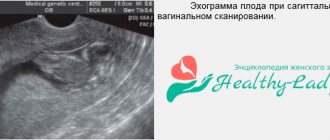Features of the ultrasound examination procedure during pregnancy
The essence of the sensor’s operation is to detect a change in the frequency of the ultrasonic wave, which occurs against the background of uneven blood flow in the vessels. The data is reflected in the form of curved lines characterizing the intensity and speed of blood flow. Doppler examines the artery, vessels, umbilical cord veins, uterine arteries, aorta and cerebral arteries of the fetus.
The procedure for studying uteroplacental-fetal blood flow does not require special preparation. Before the procedure, it is recommended to refrain from eating food for at least 2 hours. The patient must provide the doctor with:
- referral for Dopplerometry;
- results of tests and other previously conducted examinations;
- exchange card.
Doppler ultrasound is performed in the same way as transabdominal ultrasound and consists of the following steps:
- the patient lies on her back and frees her stomach from clothes;
- The diagnostician applies a gel to the area under study that improves the conductivity of ultrasonic waves;
- With light pressure, the specialist moves the sensor over this area of the abdomen;
- the sonologist analyzes the data displayed on the monitor in the form of an image, and then issues a conclusion.
Doppler examination does not require any special preparation from the expectant mother, and can be performed on the same day as a regular ultrasound. The study protocol is given to the woman immediately after the procedure, since the diagnostic results are visible immediately on the monitor.
To perform Doppler ultrasound you need:
- lie horizontally on the couch, free your lower abdomen from clothes;
- the doctor applies a special gel to the stomach that improves the conductivity of impulses;
- the doctor moves a special sensor over the abdomen, especially assessing the condition of the umbilical cord, arteries and blood vessels.
Normal blood flow during pregnancy - table
To assess the movement of blood in various vessels, several indicators are used:
- The RI or resistive index is the difference between blood flow velocities over the entire study period;
- PI or pulsation index - comparison of velocities during one circulatory cycle;
- SDO or systole-distal ratio involves assessing the speed between heart contractions and during the “rest” period.
The table shows the borderline normal values at different periods of gestation:
| Vessel | Index | 28 weeks | 32 weeks | 36 weeks | 40 weeks |
| Umbilical artery | FROM TO | 3,1-3,7 | 2,8-3,4 | 2,4-3,0 | 2,2-2,5 |
| IR | 0,65-0,73 | 0,60-0,67 | 0,55-0,63 | 0,51-0,59 | |
| Pi | 1,08-1,09 | 0,95-0,96 | 0,83-0,84 | 0,73-0,74 | |
| Fetal aorta | FROM TO | 6,0-7,6 | 5,7-7,3 | 5,4-7,1 | 5,2-6,8 |
| IR | 0,82-0,88 | 0,80-0,86 | 0,77-0,83 | 0,75-0,81 | |
| Pi | 1,79-2,24 | 1,76-2,20 | 1,74-2,17 | 1,72-2,13 | |
| Internal carotid artery | FROM TO | 5,6-6,5 | 4,7-5,6 | 4,0-4,8 | 3,3-4,1 |
| IR | 0,78-0,88 | 0,74-0,84 | 0,71-0,81 | 0,69-0,78 | |
| Pi | 1,98-2,39 | 1,7-2,06 | 1,44-1,77 | 1,22-1,51 | |
| Uterine artery | FROM TO | 1,7-1,9 | 1,7-1,9 | 1,7-1,9 | 1,7-1,9 |
| IR | 0,46-0,55 | 0,69-0,86 | 0,69-0,86 | 0,69-0,86 | |
| Pi | 0,69-0,86 | 0,69-0,86 | 0,69-0,86 | 0,69-0,86 |
If the norm is exceeded in the arteries of the uterus, this indicates an insufficient supply of oxygen to the baby; in the umbilical cord, this indicates the presence of gestosis and vascular insufficiency. When observing abnormalities in the aorta, a diagnosis of an abnormal state of intrauterine development is made; additional tests will be required to normalize the vital signs of the fetus.
To improve blood flow, a drug is used that relaxes the muscles of the uterus on an individual basis; Ginipral, Magne-B6 or Eufillin are most often prescribed. Additionally, Verapamil or Isoptin is used to reduce tachycardia.
To normalize blood flow, it is also necessary to balance the woman’s diet, food and, in general, the daily menu should contain the maximum amount of vitamins and nutrients. It is necessary to reduce the emotional and physical stress of the body so that blood circulation parameters stabilize.
Disorders determined by Doppler measurements
Disruption of blood flow in the fetal-placental system with Doppler ultrasound is manifested by an increase in IR in the vessels of the umbilical cord and aorta above normal values, while a study of blood flow in the middle cerebral artery of the fetus notes a decrease in indices below normative values. This is explained by the centralization of blood flow (that is, the blood supply to the vital organs of the fetus is primarily the brain, heart, adrenal glands).
A – violation of uteroplacental blood flow while maintaining fetal-placental blood flow;
B – violation of fetal-placental blood flow with preserved uteroplacental blood flow;
II degree: simultaneous disturbance of uteroplacental and fetal placental blood flow, not reaching critical values;
III degree: critical disturbances of fetal-placental blood flow with preserved or impaired uteroplacental blood flow.
In grade I - dynamic observation and therapy that improves blood flow with mandatory monitoring of CTG (cardiotocography - recording of the fetal heartbeat), ultrasound and Doppler once every 5-7 days. In the absence of deterioration, pregnancy is prolonged until delivery. If indicators deteriorate, daily monitoring of CTG and Doppler ultrasound is required and, if necessary, early delivery. If the fetus is in normal condition, delivery pervias naturalis (through the natural birth canal) is possible.
In grade II, CTG and Doppler testing are performed once every 2 days, also with adequate therapy. If indicators worsen, the question of early delivery is raised.
Stage III disorders are most often a direct indication for early delivery.
Doppler echocardiography is performed for the following indications:
- Fetal FGR and other pathological conditions of the fetus, where assessment of intracardiac hemodynamics is an important prognostic sign;
- Abnormal image of the heart on routine ultrasound;
- Clarification of congenital heart defects;
- Determination of the nature and severity of hemodynamic disorders;
- Presence of heart rhythm disturbances;
- Dilation of the heart chambers during routine ultrasound.
Doppler ultrasound is also used if extracardiac (non-cardiac) anomalies are suspected:
- Aneurysm of the vein of Galen (large cerebral vessel);
- Congenital malformations of the lungs, abdominal organs and kidneys;
- Placenta accreta (a pathology in which the placenta grows into the wall of the uterus and does not separate spontaneously in the third stage of labor);
- Vascular abnormalities (single umbilical artery and vasa previa).
Color flow and pulsed Doppler are also used to diagnose such a serious pathology as hydatidiform mole, which is a special case of trophoblastic disease (TB). TB is one of the most dangerous pathologies that usually manifests itself in the first trimester of pregnancy and can lead to the appearance of a malignant neoplasm (chorionic carcinoma), which previously led to very high mortality.
With this pathology, normal development of the embryo does not occur, and the placenta grows in the form of blisters that are filled with fluid. The most serious in terms of prognosis for the development of a malignant tumor is invasive (invasion - penetration into surrounding tissues) hydatidiform mole, when abnormal tissues grow into the wall of the uterus.
Diagnostics
To diagnose blood flow disorders during pregnancy, gynecologists direct the woman to undergo Doppler testing and three-dimensional ultrasound (ultrasound). When conducting this examination, the sonologist will be able to see in a three-dimensional projection how blood moves through the vessels, in which places the blood flow is obstructed and for what reason (vascular spasm or blood clot formation). Using Doppler, observing the blood flow, it is possible to determine the presence of heart defects in the fetus and the severity of their development, and to identify the presence of retroplacental bleeding. 3D ultrasound makes it possible to examine defects in any vessels of the placenta, regardless of their size, and makes it possible to monitor the formation and development of placental hemodynamics, as well as assess whether oxygen and nutrients are supplied to the child in the right quantities.
Timely detection of placental disorders during pregnancy makes it possible to prescribe adequate treatment in time and reduce the negative impact of insufficient blood circulation and the pathologies provoked by it on the child’s body.
Indications for use during pregnancy
2nd trimester
There are the following indications for ultrasound scanning:
- routine examination of the vessels in the baby’s head and the main arteries of the pregnant woman;
- exclusion or confirmation of pathologies of intrauterine development;
- abnormalities of the placenta.
The video from the Rudiamed channel talks in detail about the periods of the procedure during pregnancy.
Routine examinations in pregnant women must be done twice:
- the first - at 23-24 weeks;
- the second - at 30-34.
Ultrasound scanning is done when required, regardless of the timing, if the doctor considers it advisable to conduct Dopplerometry to eliminate risks during pregnancy or childbirth.
Diagnosis is mandatory if a pregnant woman has the following pathologies:
- diabetes;
- hypertension;
- lupus erythematosus;
- vasculitis;
- Hashimoto's thyroiditis;
- gestosis;
- kidney diseases;
- a history of frozen pregnancy or spontaneous miscarriage;
- conflict between the Rh factor of mother and child;
- unsatisfactory CTG results after 30 weeks;
- abdominal injuries.
The doctor may prescribe a study in the following cases:
- proximity of the umbilical cord rings to the baby’s neck;
- little/high water;
- suspicion of a brain or heart defect;
- presentation of the umbilical cord or its discrepancy to the proper length and/or thickness;
- placental infarction;
- the size of the fetus is less than normal;
- membrane attachment of the umbilical cord;
- premature placental abruption;
- single umbilical artery;
- hematoma or vasa previa of the umbilical cord;
- hyper/hypoplasia of the placenta.
Doppler testing during pregnancy is a diagnosis that is carried out at precisely defined times. The only exception may be the need for additional diagnostics.
Doppler testing is recommended at 18-20 and 32-34 weeks of pregnancy.
Doppler testing is done at the following periods: 18-21 weeks and 32-34 weeks. There is no point in doing Doppler before the 18th week of pregnancy, since the placental vessels have not yet had time to fully form.
In many women (about 30% of cases), the uterine arteries complete their development only at 22 or even 25 weeks. Therefore, if a one-time disruption of the blood supply is detected, the procedure should be repeated. Often, circulation naturally returns to normal between 22 and 25 weeks and no medication is required.
If there are significant changes in blood flow and pathologies are detected, the pregnant woman is prescribed full treatment, and special medical control is established over her. In this case, Doppler measurements are performed every month or half a month.
Doppler ultrasound examines the intensity of blood flow, determines the position of the child, the condition of his arteries and heart, the presence or absence of oxygen deficiency, and the entanglement of the umbilical cord.
Prevention of blood flow disorders during pregnancy
All women who want to carry a pregnancy to term without complications and give birth to a healthy child must understand that the outcome of their interesting situation largely depends on them. Gynecologists recommend that expectant mothers reconsider their diet and structure it in such a way that it contains as many vitamins and microelements as possible. If the expectant mother does not have edema, then she needs to drink 1-1.5 liters of liquid per day.
To avoid circulatory disorders in the placenta during pregnancy, you must try to control weight gain; it should not exceed 10 kg. Indeed, with excess body weight, a pregnant woman’s blood pressure increases and blood circulation worsens.
Indications for use during pregnancy
2nd trimester
Doppler testing during pregnancy is a recommended examination for every pregnant woman. Typically, it is carried out 2 times during pregnancy. Additional studies are only prescribed by a doctor.
Indications for the study:
- age less than 21 years or more than 34 years;
- unsatisfactory indicators of the aquatic environment;
- multiple pregnancy;
- maternal urinary tract diseases;
- the umbilical cord is located near the child’s neck or wraps around it;
- in case of a previous pathological pregnancy and childbirth;
- negative Rh factor of the pregnant woman;
- presence of Rh antibodies in the blood;
- fetal growth retardation syndrome;
- accelerated aging of the placenta;
- poor CTG results;
- diabetes;
- hypertension;
- unsatisfactory results of cardiotocography;
- suspicions of deviations in the development of the child’s internal organs;
- trauma during the gestational period;
- delayed onset of labor;
- gestosis.
Causes of hemodynamic disturbances during pregnancy
Hemodynamic disturbances of 1-3 degrees during pregnancy occur due to exogenous (external) and endogenous (internal) reasons.
| Internal or endogenous prerequisites develop due to the functioning of a woman’s body |
|
| Exogenous causes - external circumstances that influence the woman and the unborn child |
|
Summary values of norms for planned fetal Dopplerography: table
2nd trimester
Ultrasound without Doppler studies examines tissue only in static conditions, without being able to assess the condition, intensity of blood flow, size of blood vessels and level of blood pressure. Doppler research evaluates the dynamic environment of the body.
Ultrasound plus Doppler can detect even minor abnormalities in blood vessels, assess the speed and quality of blood flow, while a classic examination only determines the developmental features of the baby and its position inside the uterus.
Doppler safety
There is still no consensus among experts on the complete safety of Doppler examination during pregnancy. It is considered a relatively safe procedure for mother and child.
If we evaluate the percentage of harm and benefit of the study, then the benefits of Doppler measurements are much greater. And for some pathologies this diagnosis is vital.
How is this procedure carried out?
Dopplerometry is performed as follows:
- A pregnant woman lies down on the couch and exposes her belly.
- The doctor applies a gel, which should ensure a tight fit of the sensor to the skin.
- Ultrasound pulses come from the Doppler to the monitor, and the sonologist begins to study the great vessels.
An ultrasound scan lasts 15-30 minutes.
Doppler testing during pregnancy is a procedure that does not require special preparation. There is no need to diet or fill your bladder before the test. The only recommendation is to refrain from eating and smoking 2 hours before the procedure. Also, just in case, you need to take a diaper with you.
Main stage:
- It is necessary to take a comfortable position (on your back or on your side).
- Free the body area from the pubis to the chest from clothing.
- It is advisable not to move or talk during the examination.
- A gel is applied to the abdomen to facilitate the movement of the ultrasound device.
- Through the sensor, the monitor receives data on blood flow through the vessels.
- Data is displayed in monochrome or as a color image.
- The specialist analyzes the information received and prepares for the patient
- medical protocol with examination results and recommendations.
This is an ultrasound method that allows you to assess the state of blood circulation in various vessels, for example, in the uterine arteries and umbilical cord arteries. This diagnostic manipulation is based on the Doppler effect (it is often mistakenly called the Doppler effect).
This study is most informative after 30 weeks of gestation. It acts as the main method for diagnosing disorders of the uteroplacental (UPC) and fetoplacental blood flow (FPC). Doppler testing is not a mandatory procedure, but recently it has been prescribed to all pregnant patients without exception.
This manipulation is indicated for:
- premature aging of the placenta;
- insufficient or excessive volume of amniotic fluid;
- umbilical cord abnormalities;
- conflict of Rh factors of a woman and a child;
- late toxicosis;
- the patient has renal pathologies, high blood pressure, diabetes;
- suspected chromosomal abnormalities;
- non-immune hydrops fetalis;
- differences in the rate of weight gain of fetuses during multiple pregnancies;
- The expectant mother is over 35 years old.
If a child has problems with the functioning of the heart muscle, Doppler testing is performed in conjunction with cardiotocography. This technique is called Doppler echocardiography. Doppler ultrasound is often confused with Doppler ultrasound. However, these procedures are slightly different. In the first case, we are talking about a visual study of hemodynamics, when a diagnostician observes a color and graphic image of its velocity curves from a monitor screen.
During Doppler sonography, the same thing happens, only the readings are additionally recorded on the tape, which makes it possible to analyze changes in blood circulation after the treatment. In diagnostic practice, this procedure is abbreviated as Doppler ultrasound.
There are 2 types of Doppler: duplex and triplex. Duplex scanning combines 2 modes: a simple gray scale ultrasound examination and one of the modes in which the image is shown in real time. As a result, organs and vessels are visualized with the generation of data from color or spectral Doppler.
With triplex scanning, along with a gray scale image, color and pulse modes are combined. In obstetric practice, duplex scanning is most often used to determine the condition of the child in the mother's womb.
Doppler for pregnant women: detailed information about Doppler testing
Doppler for pregnant women is a highly informative, accurate and safe research method used in obstetrics to diagnose circulatory disorders in the uterus, umbilical cord and fetal vessels.
With this examination, it is possible to determine whether the blood flow is normal or whether there is a disturbance from minimal to such a level that it urgently threatens the life of the fetus.
Doppler testing during pregnancy is based on the Doppler effect - the property of an ultrasonic wave, reflecting from moving bodies, to change the frequency of its oscillations. As a result, a sensor that sends one type of sound perceives them reflected at a different frequency, this is deciphered by the program, and an image appears on the screen in the form graphics, gray-white or color pictures.
This is what Doppler ultrasound is during pregnancy.
Research Modes
- Continuous Wave: Ultrasound is sent as a continuous signal.
- Pulsed ultrasound mode with Doppler during pregnancy: the wave is sent not constantly, but in cycles. As a result, the sensor catches the reflected ultrasound, sends it for processing, and at the same time “produces” a new “portion” of signals.
- Doppler ultrasound during pregnancy can also be performed in color mapping mode. It is based on the same method, only the speed of blood flow in different parts of the vessels is coded in different colors. These shades are superimposed on a two-dimensional image, which can also be seen with a regular ultrasound. That is, if you see different colors on the monitor, these are not arteries (red) and veins (blue), but vessels with different speeds of blood flow, which can be directed from the sensor and to the sensor.
In what cases are they examined?
- if the ultrasound shows umbilical cord loops near the fetal neck
- to identify pathology of the placenta
- with low or polyhydramnios
- Ultrasound suggests a malformation of the heart or brain
- according to the results of an external obstetric examination or ultrasound, the fetus is smaller than it should be at this stage
- if the mother has preeclampsia, diabetes mellitus, autoimmune diseases (for example, lupus erythematosus, vasculitis, Hashimoto's thyroiditis), kidney disease, hypertension
- two or more fruits, especially if they vary greatly in size
- “frozen” previous pregnancy
- I had a spontaneous miscarriage before
- Ultrasound shows abnormalities of the umbilical cord
- conflict between mother and fetus due to Rh factor
- pregnant abdominal injury
- “bad” CTG results after 30 weeks
At what stage is Doppler testing done for pregnant women?
At what period is Doppler ultrasound performed? This study during pregnancy can be carried out when the placenta is fully formed, that is, by 16-18 weeks of pregnancy.
It is at this time that the uteroplacental basin, which has low vascular resistance, can be clearly visualized.
There is no point in performing Doppler before this period. It’s better to combine ultrasound with Doppler with a regular ultrasound examination performed at 20-22 weeks.
How to prepare for research
There is no need to prepare for a Doppler ultrasound during pregnancy. You can eat the day before, or come on an empty stomach - the quality of the results does not depend on this. The bladder also does not need to be filled for examination.
How is ultrasound with Doppler ultrasound performed during pregnancy?
The woman lies down on the couch, and a small amount of special gel is applied to her stomach so that Doppler measurements can be carried out without errors that may occur if air gets between the sensor and the skin. The duration of a Doppler ultrasound during pregnancy is about 30 minutes.
The procedure is simple and painless for the patient. A vaginal sensor is not used.
What vessels are assessed during Doppler examination?
Doppler for pregnant women has several main indicators that help assess the blood flow and patency of each vessel separately. Many of them depend on the stage of pregnancy.
The most informative Doppler ultrasound during pregnancy evaluates the following vessels:
- uterine arteries
- umbilical cord arteries
- fetal middle cerebral artery
- aorta of a developing baby.
The umbilical cord arteries are the most studied vessels. It is with changes in speed characteristics that the oxygen supply to the fetus suffers.
The nature of blood circulation in them allows one to judge the fetal-placental blood flow, microcirculation in that part of the placenta that directly supplies the fetus.
Data decryption
Doppler for pregnant women evaluates blood supply based on the following indicators:
- The systole-diastolic ratio (SDR or S/D) is an indicator that is obtained if the maximum velocity in the vessel during systole (when the heart contracts) is divided by the end-diastolic (when the heart muscle “rests”) velocity. The indicator for each vessel has its own meaning.
- Doppler testing during pregnancy also evaluates the “resistance index” (IR). It is obtained if the difference between the maximum (systolic) and minimum blood flow speeds is divided by the maximum speed.
- PI (pulsatility index): if you divide the difference between the maximum and minimum speeds by the average speed of blood flow over a complete cardiac cycle.
All three of these indicators are called “vascular resistance indices” (VRI). These are the main “whales” of assessing the state of blood flow. In order to evaluate them correctly, the specific indicator for each vessel is compared with standard tables taking into account the gestational age.
How to make sense of all these numbers
The placenta communicates with the uterus through terminal villi. These are branches that have a huge number of vessels and are the main place where oxygen and nutrients pass to the fetus, and waste products are removed.
If the pregnancy is progressing normally, Doppler ultrasound shows no changes. As soon as the number of vessels in these villi decreases due to various reasons (this is called feto-placental insufficiency), vascular resistance in the umbilical cord artery increases, and SDO and IR increase.
Normally, Doppler ultrasound during pregnancy determines them as follows: 1. IR of the umbilical cord arteries:
- weeks 20 to 23: 0.62-0.82
- 24-29 weeks: 0.58-0.78
- from 30 to 33 weeks: 0.521-0.75
- 34-37 weeks: 0.482-0.71
- 38-40 weeks: 0.42-068.
2. Systole-diastolic ratio in the umbilical artery
| Duration in weeks | S/D |
| From 16 to 19 | 4,55- 4,67 |
| 20—22 | 3,87- 3,95 |
| 23—25 | 3,41-3,61 |
| 26—28 | 3,191-3,27 |
| From 29 to 31 | 2,88-2,94 |
| 32—34 | 2,48-2,52 |
| 35—37 | 2,4-2,45 |
| 38—41 | 2,19- 2,22 |
If the uteroplacental blood flow is affected, then similar increases in ASC visible on Doppler ultrasound during pregnancy will be observed in the uterine arteries. The indicators of blood flow in the uterine arteries determine whether intrauterine growth retardation will occur in the child.
3. Norm of SDO in the uterine arteries
| weeks | Norm |
| 16-19 | 2,5-2,10 |
| 20-22 | 1,910-1,98 |
| 23-25 | 1,89-1,93 |
| 26-28 | 1,81-1,85 |
| 29-31 | 1,76-1,80 |
| 32-34 | 1,7-1,76 |
| 35-37 | 1,66-1,7 |
| 38-41 | 1,67-1,71 |
4. PI in the uterine arteries in the third trimester, which allows Doppler ultrasound of pregnant women: 0.40-0.65.
On video: Doppler testing of a pregnant woman
5. Average IR in the uterine arteries in the third trimester: 0.3-0.9.
If, as a result of decreased blood flow in the vessels of the placenta and/or uterus, the child begins to suffer, this can be detected by changes in the ASC in the fetal aorta. Then you will see that these numbers are higher than the standard indicators calculated for Doppler ultrasound during pregnancy:
6. SDO in the fetal aorta:
- 16-19 weeks: 6.06-6.76
- 20-22 weeks: 5.38-6.2
- from 23 to 25 weeks: 4.86-5.24.
7. IR in the fetal aorta: on average 0.75.
If the blood supply to the fetus suffers so much that, instead of developing, it can only maintain its vital functions, this can be seen by an increase in IR and SDO of the carotid and cerebral arteries of the fetus.
8. IR of the middle cerebral artery at 22 weeks and before birth: normal - 0.773.
9. SDO of the cerebral middle artery (22 weeks or more): normal – more than 4.4.
10. IR of the fetal carotid internal artery, which is determined by Doppler ultrasound during pregnancy:
- from 23 to 25 weeks: 0.942
- 26-28 weeks: 0.88-0.90
- Weeks 29-31: 0.841-0.862
- 32-34 weeks: 0.80
- from 35 to 37 weeks inclusive: 0.67-.85
- more than 38 weeks: Doppler during pregnancy shows the norm at 0.62-0.8.
What pathologies are detected
- Preeclampsia. In this condition, Doppler measurements during pregnancy usually first show an increase in IR and SDO in the uterine arteries, then the same changes occur in the umbilical cord arteries.
- In case of postmaturity, Rh conflict and diabetes mellitus of the mother, Doppler ultrasound during pregnancy will show an increase in IR and SDO in the umbilical cord artery and aorta of the child.
- If the pregnancy is multiple, and the fetuses develop unevenly, then Dopplerography during pregnancy will show increased rates of IR and SDO in the umbilical cord artery of the less developed fetus. If the indicators are the same in both fetuses, but one of them lags behind in development, this means that in this case transfusion syndrome occurs.
Also, ultrasound with Doppler during pregnancy not only helps to establish a diagnosis of circulatory disorders at some level in the “fetus-placenta-mother” system, but also to determine its degree. If a high degree of disturbance of the utero-fetal-placental circulation is detected, depending on the situation, both mandatory treatment and emergency delivery may be prescribed.
About the cost of the examination
The price for Doppler ultrasound during pregnancy ranges from 1000 to 3500 rubles; the study can be carried out in specialized centers, in some maternity hospitals. If you have the special indications mentioned above, then Doppler ultrasound during pregnancy should be prescribed by an obstetrician-gynecologist and carried out in the context of medical genetic consultations using expert-class devices.
Thus, Doppler for pregnant women is an informative and objective diagnostic method, which must be evaluated by the doctor who is monitoring your pregnancy. It helps not only to timely identify pathology in the vessels of the fetus, uterus and placenta, but also to make a prognosis and assess the degree of blood flow disturbances. You shouldn’t take the risk of seeing a “bad” ultrasound doctor’s conclusion and try to decipher the results yourself: it’s quite difficult to figure it out, and sometimes the clock counts.
See how the Doppler ultrasound process of a pregnant woman is displayed on the monitor screen.
Types of Doppler
Doppler testing comes in two types: duplex and triplex. Duplex Doppler is considered less informative. The results are reflected on the screen in monochrome, ultrasonic signals are sent several times. When a signal arrives, it is displayed on the screen, followed by the next signal of ultrasonic waves.
Triplex Doppler is more informative and accurate. It displays the received information in the form of a color scheme. Venous and arterial blood flows are displayed on the monitor in blue and red shades, providing a more informative and accurate picture.
The procedure usually lasts no more than half an hour. If data on the state of blood flow is difficult to obtain, then the diagnosis may be reassigned.
Features of the method
Doppler testing during pregnancy is one of the types of functional ultrasound diagnostics that examines the nature and intensity of uteroplacental and fetal blood flow.
The essence of the sensor’s operation is to detect a change in the frequency of the ultrasonic wave, which occurs against the background of uneven blood flow in the vessels. The data is reflected in the form of curved lines characterizing the intensity and speed of blood flow. Doppler examines the artery, vessels, umbilical cord veins, uterine arteries, aorta and cerebral arteries of the fetus.
Explanation of research results, normal indicators by week of pregnancy
- assess the uniformity of blood flow;
- pay attention to the presence of grooves or changes in the shape of blood vessels;
- study the peaks of maximum systolic and end-diastolic blood flow velocities.
Movement of blood flow during the cardiac cycle
The results of Doppler ultrasound must be compared with the average normal values contained in the tables, where:
- SDO is the systole-diastolic ratio (shows how many times systole exceeds diastole);
- IR - resistance index (difference in the ratio of systole and diastole to systole);
- PI - pulsation index (the difference between systole and diastole in relation to the average flow velocity inside the vessel).
Interpretation of results
Doppler measurements evaluate 3 indicators:
- Uteroplacental blood flow. The intensity of blood flow through the uterine arteries is assessed. These indicators reflect the condition of the placenta and how it performs its functions. If this blood flow fails, a woman may develop gestosis and the child’s health may deteriorate.
- Fetal-placental blood flow. Its speed and permeability informs whether the fetus receives enough nutrients and oxygen. If blood supply is difficult, there may be a deficiency of nutrients and oxygen, which are vital for the fetus. Disruption of this blood flow contributes to the syndrome of child development delay and hypoxia.
- Fetal blood flow. Involves blood supply through the carotid, middle cephalic artery, as well as aortic circulation.
Indicators used:
- resistance index (RI);
- systole-diastolic ratio (SDO = S-D);
- pulsation index (PI).
Formula for RI:
- RI = (S-D)/S., where C is the maximum blood flow velocity in systole, and D is in diastole. Formula for pulsation index:
- PI = (S-D)/M. M is the average blood flow speed.
Possible blood flow disorders and treatment tactics
There are several degrees of disturbances in utero-fetal-placental blood flow. Treatment of abnormalities depends on which of them they are classified as. In some cases, special treatment measures are not required. The table provides information about possible hemodynamic deviations and ways to eliminate them.
| Degrees of disturbances of utero-fetal-placental blood flow | Description | Fetal hazard level | Treatment | |
| 1 | 1A | Impaired blood flow only in the arteries of the uterus | Absent | Not required. The problem can be solved by daily long walks, good sleep, proper nutrition and regular physical activity. |
| 1B | Impaired blood flow exclusively in the umbilical cord arteries | Average | Drugs that improve blood circulation are used. If blood clotting is high, blood thinners are indicated. | |
| 2 | Simultaneous disturbance of hemodynamics in the uterine arteries and umbilical cord with undisturbed blood circulation in the ductus venosus | High | Treatment is carried out in a medical facility. Every 2 days the patient undergoes Doppler echocardiography. | |
| 3 | Critical disturbance of hemodynamics in the umbilical cord, regardless of this process in the uterine arteries | They resort to emergency delivery. | ||
Deviations in the relative normative values of blood flow indicate a certain stage of impairment of MIC and PPK.
There are 3 stages of blood supply disturbance:
- At stage 1, there can be two types of deviations: 1) The PPC is violated, but the MPC is preserved; 2) The IPC is violated, but the IPC is maintained.
At this stage, it is quite possible to carry the baby to term and give birth naturally, if the situation does not worsen in the future and if the heart rate is normal according to the results of cardiotocography.
- At stage 2, deviations in blood supply are observed in the umbilical and uterine arteries. Stage 2 requires constant medical monitoring of the pregnant woman, regular Doppler testing and cardiotocography. The pregnant woman is also admitted to the hospital and special treatment is prescribed to prevent or treat fetal growth retardation syndrome and hypoxia.
- The 3rd stage indicates critical indicators in the ACC and MIC, the blood supply is practically absent, the speed reaches zero, and reverse blood flow can even be observed.
In stage 3, urgent surgical delivery is recommended if the gestational age is more than 30 weeks. If the period is shorter, then intensive therapy is prescribed in combination with CTG and ultrasound to prolong the pregnancy to 30 weeks.
Diagnosis of disorders of varying degrees
To diagnose metabolic disorders in the blood flow between the fetus and the woman, a number of types of diagnostics are used, aimed at establishing the source of the problems, as well as the degree of their severity.
The most effective diagnostic methods are:
- obstetric examination;
- laboratory examination;
- dopplerography studies.
Obstetric examination
Changes that occur in the baby's motor activity and heart rate, with impaired blood flow during pregnancy, can be suspected not only by the doctor leading the pregnancy, but also by the woman herself. Both excessively intense tremors of the baby inside the abdomen and their complete absence should cause concern.
Starting from approximately 28-30 weeks, a woman should record the number of kicks of the baby (using tables, electronically) during the day and provide this data for analysis over time to the doctor.
During the examination, the obstetrician-gynecologist must listen to the fetal heartbeat at each appointment, and if there are alarming signals, he prescribes additional examinations. Also, during an obstetric examination, a delay in fetal maturation may be initially detected in the event of a discrepancy between the volume of the abdomen and the actual gestational age.
The obstetric examination consists of:
- internal examination – is an examination on a chair and allows you to assess the condition of the birth canal and the maturity of the cervix. It is performed manually and requires compliance with the rules of asepsis and antisepsis (use of gloves and disinfectants by a specialist);
- external examination - includes a visual examination, measurement of the volume of the pregnant woman’s abdomen, palpation and auscultation (listening).
Laboratory research
If the doctor has doubts about hemodynamics during pregnancy, he will definitely send the pregnant woman for additional tests to get a full clinical picture. To do this, pregnant women are prescribed to donate biomaterial - urine and blood.
Indicators that may indicate the presence of abnormalities in the communication of the bloodstream between the child and the mother are:
- detection of protein in a urine test (indicates the development of gestosis);
- decreased hemoglobin (leads to a lack of oxygen in the baby).
Doppler studies
This is a diagnosis that involves the use of Doppler and ultrasound, using which the doctor is able to comprehensively assess hemodynamics in the “woman-placenta-unborn child” complex.
Doppler is a special device that shows how blood flows through the vessels and allows you to estimate at what speed this is happening. Thanks to this examination, the doctor receives a complete clinical picture of the state of this system, which allows timely detection of deviations in its development.
It is Doppler ultrasound that allows you to make a reliable diagnosis and identify the degree of circulatory disorders. This method detects even minimal manifestations of deviations from normal indicators and is absolutely safe for both the expectant mother and the child.
During the manipulation, a schematic model of the blood flow existing between the woman and the baby is built on the monitor screen. The results of this examination make it possible to predict the development of pregnancy in the future and, if necessary, correct disorders.
In addition to Doppler ultrasound, ultrasound diagnostics and cardiotocography (CTG) help to identify abnormalities in the development of the child and imbalances in blood circulation between the fetus and the woman. Ultrasound allows you to assess placental hemodynamics, and CTG can record the frequency of fetal heart pulsations.
What to do if a pathology is detected
Doppler testing during pregnancy is prescribed to all expectant mothers. This is a vital examination that helps prevent serious pathologies in the “mother-placenta-fetus” structure. Hypoxia, a syndrome that threatens the health and life of the fetus, is most often diagnosed using Doppler. If even mild oxygen deficiency is detected, treatment is extremely necessary.
First of all, when hypoxia is diagnosed, a pregnant woman is hospitalized in an inpatient department. Doctors direct therapy to normalize fetoplacental blood supply and correct existing diseases in the mother that contribute to the complication of hypoxia.
Medicines are prescribed to reduce the tone of the uterus and reduce intravascular coagulation. Oxygen therapy is prescribed. A pregnant woman needs complete physical and moral rest.
In case of chronic oxygen starvation, a pregnant woman is prescribed antihypoxants; preparations for a deeper supply of oxygen to cells; medications that improve metabolism; neuroprotectors. If the hypoxia condition improves, the pregnant woman is recommended to do water and breathing exercises and ultraviolet radiation therapy.
If oxygen starvation persists or worsens (if the pregnancy is 28 weeks or more), urgent delivery in the form of a cesarean section is prescribed. During childbirth, acute hypoxia may occur, in which case the child is given urgent resuscitation therapy.
Timely and correct therapy of oxygen starvation, compliance with medical recommendations help prevent complications caused by hypoxia and give birth to a healthy, strong child. All children who have survived a state of hypoxia are observed for a certain time by a neurologist. In some cases, it is additionally necessary to visit a speech therapist and psychologist.
Among the severe consequences of hypoxia are:
- various lesions of the central nervous system;
- convulsions;
- swelling of the brain;
- pulmonary hypertension;
- diseases of the heart and blood vessels;
- renal failure;
- disruption of the gastrointestinal tract;
- immune diseases;
- hemorrhagic diathesis;
- infant asphyxia.
Prevention of hypoxia should begin with preparation for pregnancy, namely giving up bad habits, treating existing extragenital pathologies, diseases of the genital organs, and sexually transmitted diseases.
Doppler testing can be done in both private and public clinics. The significant difference is that when going to a government institution, it is unlikely that you will be able to choose a specialist and equipment, which cannot be said about private clinics.
Before choosing a private hospital, you can and even need to find out what specialists work there, what kind of work experience and length of service they have, and read reviews about doctors on trusted online resources. It is possible to find out information about the quality of doctors’ work from friends who have already been examined by them.
It is worth paying attention to the equipment used, its condition, manufacturer, brand. You can also read the technical specifications of the device, which can be easily found on the Internet on specialized sites.
Some patients pay special attention to the atmosphere and decor in a specialized center, to the level of customer service, and to the appearance of the medical staff. Although these criteria are not key for choosing a research location.
The price range for Doppler measurements is quite wide. The cost of such a study varies from 1 thousand to 3.5 thousand rubles.
Disturbance of uterine placental blood flow 1a degree
The placenta is one of the most important organs formed in the uterus of a pregnant woman. It is the main link between the blood circulation of the expectant mother and the baby. With the help of the placenta, the child receives oxygen and nutrients , which take part in the formation and formation of his organs, and with its help, metabolic products are removed.
Violation of placental blood flow (or disturbance of uterine blood flow) leads to the development of placental insufficiency and, as a consequence, to the death of the baby.
During pregnancy, mandatory screening is carried out three times, including ultrasound examination, which allows timely detection of abnormalities, determination of a plan for pregnancy and delivery, prescribing adequate treatment, and also preventing death or abnormalities in the development of the child.
Features of blood circulation between the fetus and mother
The fetal-maternal circulatory system includes structures such as the umbilical arteries and veins, as well as the placenta.
Blood enters the placenta through the uterine arteries. The structure of the walls of these vessels is such that their muscle fibers can contract, thereby blocking the lumen. Until pregnancy, this mechanism allows you to reduce blood loss during menstruation.
In the fourth or fifth week of attachment of the fertilized egg, the layer of muscle in the vessels disappears and the flow of blood to the placenta is no longer controlled by vascular contraction. By the sixteenth week, the arteries have completely changed for continuous blood supply. This feature becomes dangerous when bleeding develops, since it is not possible to stop it by contracting the blood vessels.
During a normal pregnancy, the placenta is attached to the inner lining of the uterus with the help of villi, which penetrate deeply into the mucous membrane. The villi grow into the vascular walls and come into contact with the mother’s blood, carrying out metabolism at the cellular level.
In addition, the vessels of the umbilical cord (a vein and two arteries) also take a direct part in the fetal circulation. Blood flows to the baby through the umbilical arteries and flows to the placenta through the umbilical vein.
Disturbances in the circulatory system between the placenta and the fetus can lead to abnormalities in the development of internal organs and cast doubt on the birth of a healthy child.
Causes of placental blood flow disturbances
There are several groups of factors, one of which is associated with pregnancy, and the other with maternal diseases.
Problems during pregnancy
Pregnancy pathologies that can lead to hemodynamic disturbances in the uteroplacental blood flow are:
- Placenta previa . In this case, the placenta is attached in the lower parts of the uterus, where the muscle layer is thinner and less blood flows to the fetus. The same situation occurs when the placenta is attached to scar tissue.
- Late toxicosis . As a result of the development of this disease, damage to small uterine vessels occurs.
- Anemia . When hemoglobin levels are low, the heart rate increases and, as a result, blood flow through the arteries of the uterus increases to replenish the oxygen deficiency. The circulation in the placental-uterine circle also changes.
- Rh conflict , that is, incompatibility of the blood of the fetus and mother, leads to the development of anemia and hemolytic disease of newborns. A similar situation can arise when transfusion of blood of another group.
- Increased load on the kidneys during toxicosis leads to an increase in blood pressure , which also contributes to changes in blood flow.
- Pathologies of development of umbilical cord vessels . For example, the presence of only one umbilical artery leads to insufficient blood supply to the fetus.
- Multiple pregnancy . In this case, the placenta is enlarged, which means it requires more nutrition. Sometimes there is a redistribution of blood flow between fetuses (the so-called fetotransfusion syndrome). In this case, one fetus (donor) receives less blood and has less weight than the other (recipient). Moreover, a larger fetus experiences greater stress on the heart.
Mother's illnesses
- Acute maternal infections during pregnancy. Bacteria and viruses can cross the placental barrier and damage blood vessels.
- Anomalies of uterine development. For example, a bicornuate uterus that has a septum in the cavity that divides it into two parts, while pregnancy can develop only in one of these parts, as a result of which there is no connection between the arteries, the vascular network is underdeveloped, which leads to hypoxia of the placenta.
- Endometriosis is damage to the inner surface of the uterus that occurs as a result of numerous abortions, sexually transmitted infections, alcohol consumption and smoking.
- Neoplasms of the uterus. Pregnancy provokes the growth of tumors, as a result of which the tumor takes away part of the blood flow from the fetus.
- Diabetes mellitus, which damages the vascular walls.
Source: https://rodinkam.com/nuzhno-znat/narushenie-matochnogo-platsentarnogo-krovotoka-1a-stepeni











